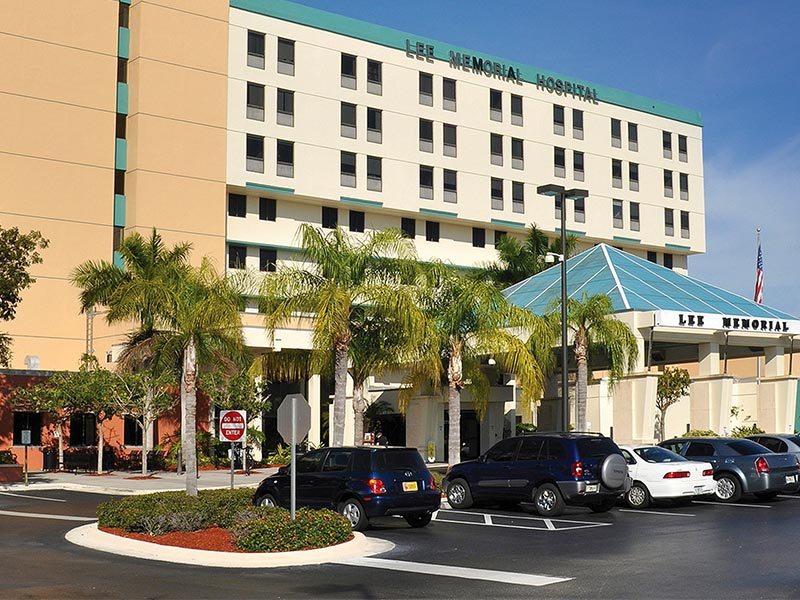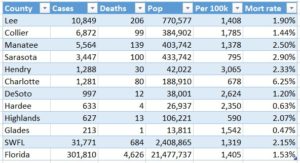
Southwest Florida has become home to greater than 10% of all known COVID-19 patients in Florida. The mortality rate for the 10-county region remains higher than the state as a whole.
But with a lower median age for patients than at the beginning of the pandemic, the death rate has slid downward even from just a week ago.
Lee County, the most populous in the region, saw deaths climb above 200 this week. With a total case load of 10,849 dating back to the start of the pandemic, a total of 206 residents have died from the disease. That goes back to the first known coronavirus infection in the county, a woman tested positive posthumously. At this stage, the county has seen about 1.9% of patients with COVID-19 die, a mortality rate just slightly higher than the state as a whole.
The median age for patients in the county remains at 41, slightly higher than the statewide media of 39. The county was just the eighth in Florida to reach a five-digit caseload. The Health Department reported a huge spike on Saturday when 1,244 patients had positive test results come back.
Some confusion struck on Tuesday when Health Department report suggested Lee Health had a 100% positivity rate out of its laboratory, but Lee Health spokesman Jonathan Little said that was not the case and the hospital system is working to address the discrepancy. In reality, Lee Health labs have reported a positivity of 18.1% since the start of the pandemic. On Monday, the lab saw positivity reach 28.5%, much higher than the state as a whole. Those rates are separate from county and statewide rates.
More than 90% of ICU rooms were in use at Lee Health hospitals as of Tuesday, and about a quarter of those are occupied by COVID-19 patients.
The infection rate for the 10-county region continues to climb, with about 1,405 cases per 100,000 residents. That means roughly 1.4% of Southwest Florida residents have tested positive.
The greatest infection rates remain in some of the more rural counties. In Glades County, where only one person has died during the pandemic, about 1.3% of the population has been tested positive for COVID-19.
The highest infection rate remains in Hendry County, where the infection rate has now reached 3,065 cases per 100,000 people, meaning more than 3% of the population has had COVID-19. That’s been fueled by an outbreak in Immokalee. In the Zip code serving the community, which spans parts of Hendry and Collier counties, there have been a total of 1,790 reported cases.
Collier County has also steadily seen its numbers spike, to where the county now has 6,872 cases days after crossing the 6,000 threshold. A total of 99 have died in the county, which has the highest infection rate of any coastal county in the region, with 1,785 cases per 100,000 residents.
But every zip code in Hendry, which the Census estimates has a population of just over 42,000 people, has turned into a hot spot.
Most of DeSoto County has been designated that way as well, with 948 in the Arcadia Zip code testing positive.
Of the 31,771 positive tests in the 10-county region, 7,739 have come back in the past two weeks and 13,534 were recorded since the start of July.

Editor’s note on methodology: The Florida Department of Health releases new data every morning around 10:45 a.m. The total number reported in those daily reports include the previous day’s totals as well as the most up to date data as of about 9:30 a.m.
Florida Politics uses the report-over-report increase to document the number of new cases each day because it represents the most up-to-date data available. Some of the more specific data, including positivity rates and demographics, considers a different data set that includes only cases reported the previous day.
This is important to note because the DOH report lists different daily totals than our methodology to show day-over-day trends. Their numbers do not include non-residents who tested positive in the state and they only include single-day data, therefore some data in the DOH report may appear lower than what we report.
Our methodology was established based on careful consideration among our editorial staff to capture both the most recent and accurate trends.




One comment
Zooly
July 15, 2020 at 1:23 pm
any mention of the 100+ testing centers that all tested 100% positive? The data is incorrect, folks.
The number is not nearly this high, but God forbid any journalist do any real journalism. SHAME ON YOU.
You’ve squandered your last bit of credibility. Citizens, your media does not work for you.
Comments are closed.